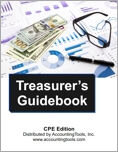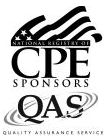Treasurer's Guidebook (CPE Course)
CPE Credit: 16 hours
Course Type: Downloaded PDF materials with online test
Price (with PDF Textbook): $110
Course Description
The treasurer can provide significant value to a business, not just by managing its money, but also through fundraising activities and proper attention to the management of credit and risk. The Treasurer's Guidebook shows how to enhance the treasurer position; it does so by discussing how the treasury department’s performance can be organized and fine-tuned, focusing on bank relations, cash concentration systems, investment strategies, financing sources, credit management, insurance, and more. The course also addresses the administrative aspects of the treasurer’s job, including the accounting for treasury transactions, treasury management systems, controls, and measurements. In short, this course is the ultimate toolkit for anyone intending to expand and improve the treasurer position.
Note: This course shares some chapters with the Corporate Cash Management and Corporate Finance courses.
Author: Steven Bragg
Course Number: FN1024
Table of Contents
Chapter 1. Treasury Management
Chapter 2. Bank Relations
Chapter 3. Cash Concentration
Chapter 4. Cash Forecasting
Chapter 5. Clearing and Settlement Systems
Chapter 6. Investment Management
Chapter 7. Equity Financing
Chapter 8. Debt Financing
Chapter 9. Supply Chain Financing
Chapter 10. Treasury Risk Management
Chapter 11. Insurance
Chapter 12. Credit Management
Chapter 13. Working Capital Management
Chapter 14. Accounting for Treasury Transactions
Chapter 15. Treasury Management Systems
Chapter 16. Treasury Controls
Chapter 17. Treasury Measurements
Learning Objectives
Recognize the responsibilities of the treasury function.
Identify the circumstances under which local treasury expertise is needed.
Specify the activities of the different parts of the treasury department.
Specify the different types of bank fees.
Identify the circumstances that could trigger a credit assessment.
Specify the benefits of a cash concentration system.
Recognize the effects of a threshold cash sweep.
Recognize how notional pooling functions.
Identify the circumstances under which multi-tiered banking is used.
Identify the type of cash pooling that works best when managers want local control.
Specify the methods and adjustments used to develop a cash forecast, and why a cash forecast reconciliation is used.
Identify the need for a correspondent bank.
Recognize the different types of settlement systems.
Specify the different types of investment strategies.
Recognize the characteristics of the different types of investments.
Identify the reasons why a secondary market is needed.
Identify the different techniques available for selling shares outside of an initial public offering, and the restrictions associated with their use..
Identify the terms used for factoring and hard money deals.
Specify the circumstances under which a supply chain financing offer would be accepted.
Identify the types of hedging transactions that can be used to mitigate risk, note the terms of hedging contracts, and recognize when risk mitigation is not needed.
Recognize the types of insurance sales channels.
Specify the methods used to review the financial condition of insurers.
Identify the terms included in insurance contracts, and their effects.
Identify the benefits and coverage characteristics of the different types of insurance.
Recognize the methods used to reduce the cost of insurance.
Specify the documentation typically used in a credit review.
Recognize the uses to which a credit policy can be put.
Identify the characteristics of a high-quality credit rating system, and when it works best.
Identify the indicators of possible future payment delinquencies.
Identify the actions needed to achieve zero working capital.
Specify the accounting required for the different investment activities, as well as the accounting for impairment losses, and why investments are assigned to different classifications.
Specify the accounting required for hedging transactions, the types of hedges, and the characteristics of a highly effective hedge.
Recognize the costs and advantages of a treasury management system.
Identify the controls for cash forecasting, investments, debt, and stock issuances.
Recognize the formulas for turnover measurements, investment returns, and the ability to pay.
Level: Overview
Instructional Method: QAS Self-Study
NASBA Category: Finance
Prerequisites: None
Advance Preparation: None
Latest Review Date: August 2024
Program Registration Requirements: Click on "Purchase Course" near the top of this page to pay for and access the course. You will then be able to download the course as a PDF file, then take an on-line examination, and then download a certificate of completion if you pass the examination.
Program Refund Policy: For more information regarding administrative policies concerning complaints, refunds, and other matters, see our policies page.
AccountingTools, Inc. is registered with the National Association of State Boards of Accountancy (NASBA) as a sponsor of continuing professional education on the National Registry of CPE Sponsors. State boards of accountancy have the final authority on the acceptance of individual courses for CPE credit. Complaints regarding registered sponsors may be submitted to the National Registry of CPE Sponsors through its website: www.nasbaregistry.org.
The NASBA sponsor identification number for Accountingtools, Inc. is 115881.
AccountingTools is an IRS Approved Continuing Education Provider. We are compliant with the requirements for continuing education providers (as described in sections 10.6 and 10.9 of the Department of Treasury’s Circular No. 230 and in other IRS guidance, forms, and instructions). Our IRS Approved Continuing Education Provider number is 72821.


